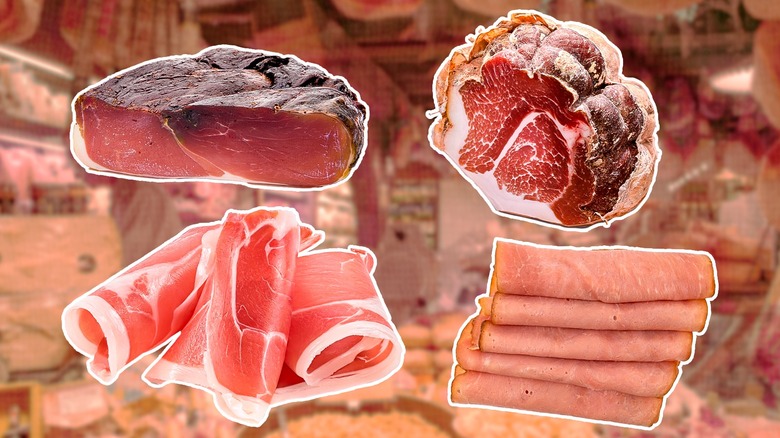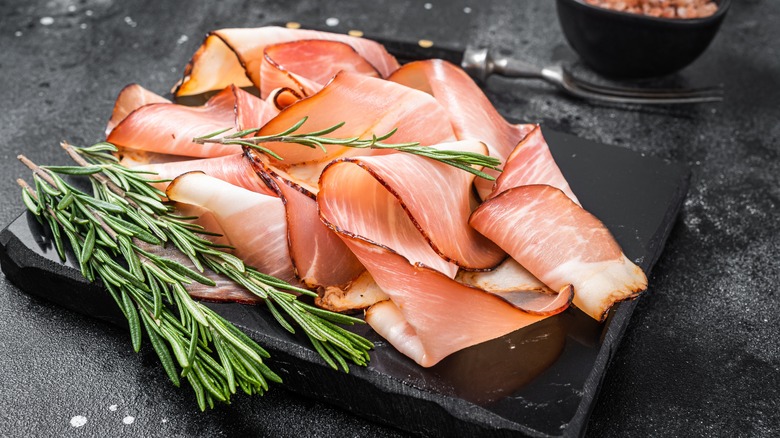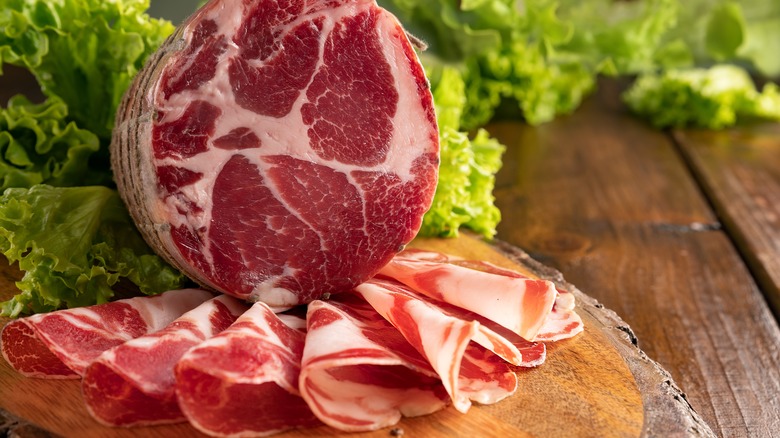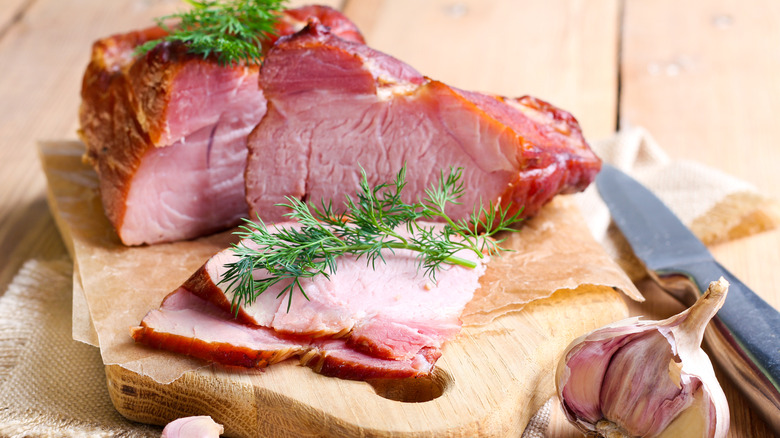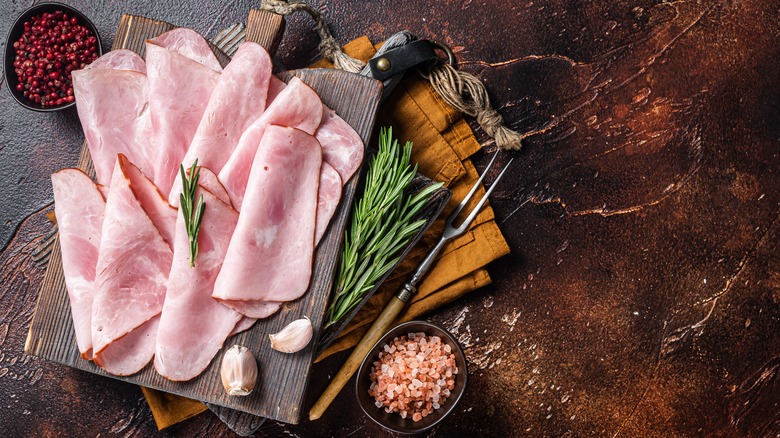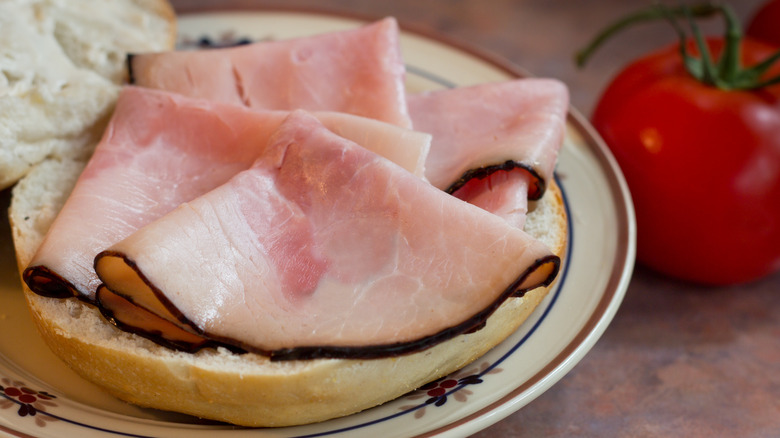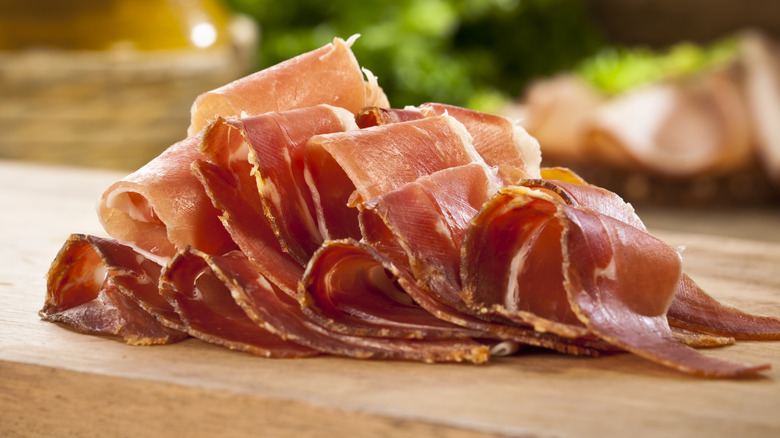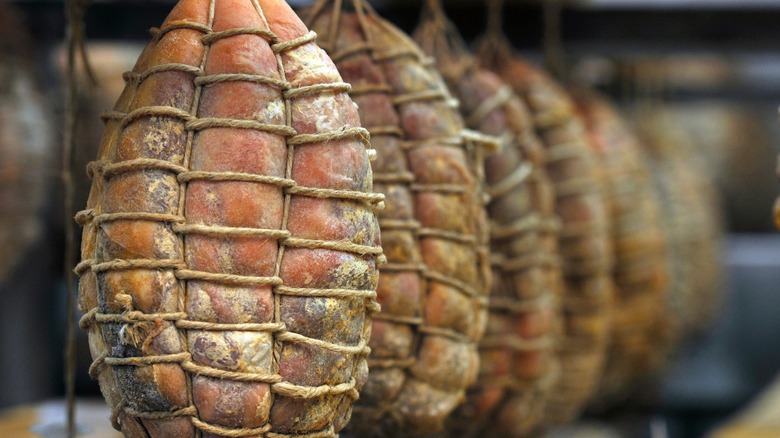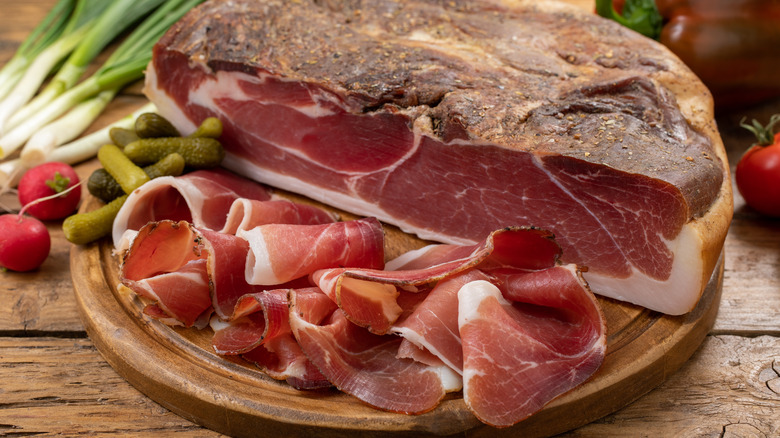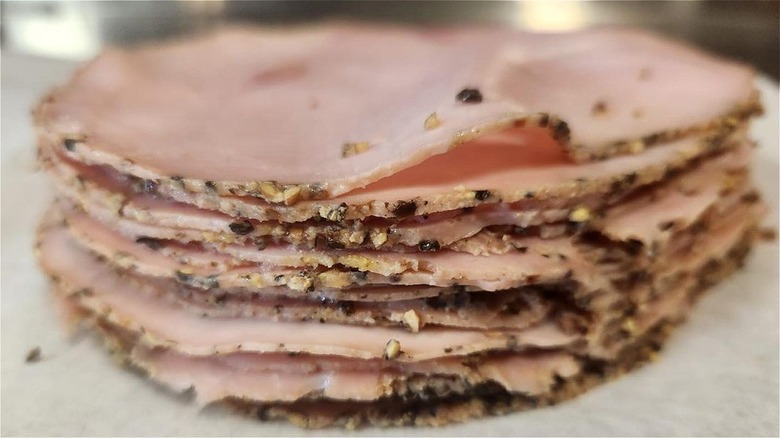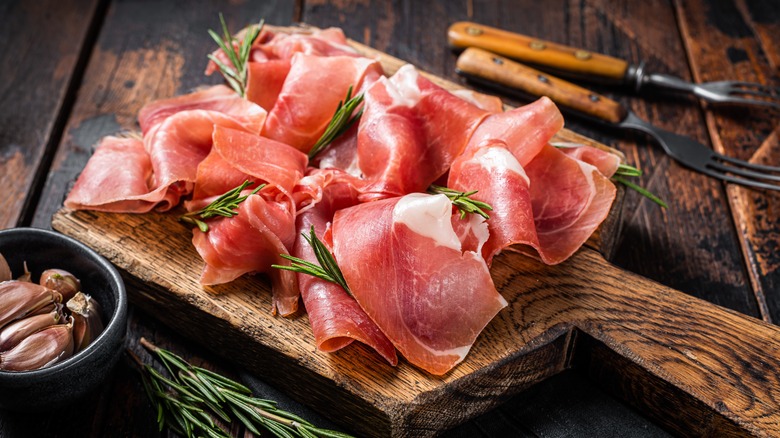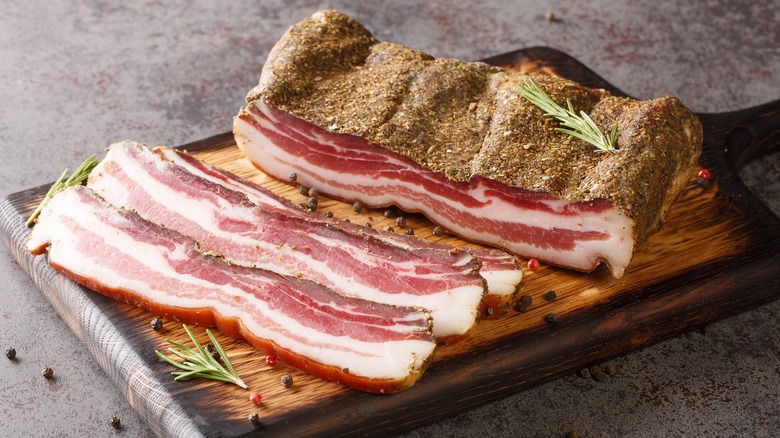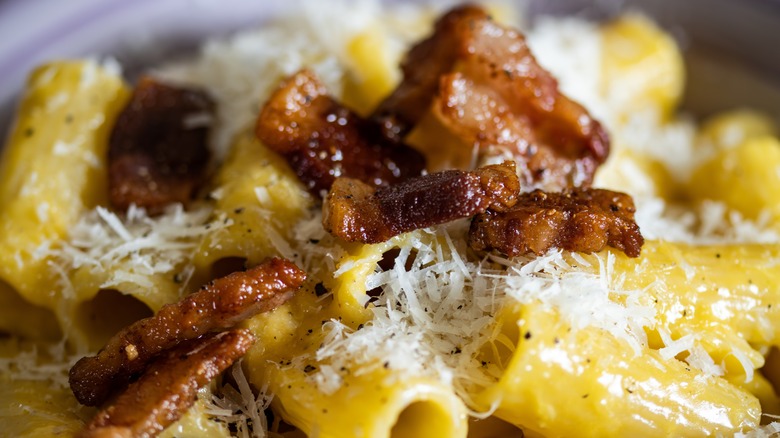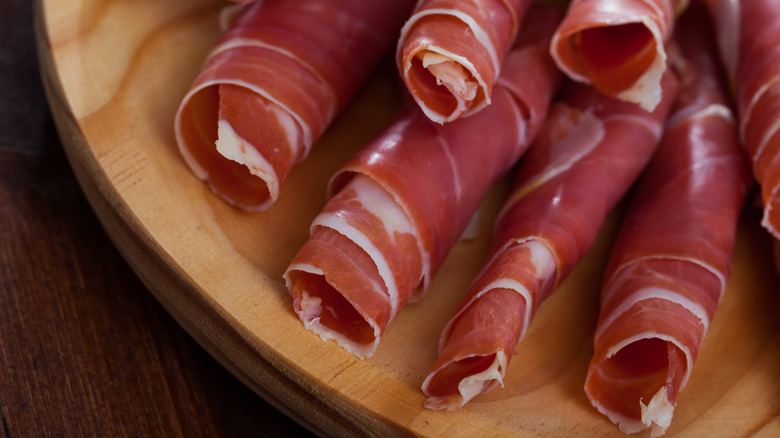19 Varieties Of Ham You'll Find At A Deli
It's not outlandish to assume you've had ham at least once in their life. Maybe you enjoy the classic deli specialty as an easy-to-make lunch, or prefer it deconstructed and served in a salad. But no matter your preference, if you're like many modern consumers? Chances are you don't put too much thought into the type of ham you're buying or serving. Yet with numerous varieties available worldwide, the type of deli ham you use in a dish could make a big difference to its overall appeal.
With that in mind, it's worth taking a moment to consider the different types of deli ham — and their flavor profiles — before making your grocery list. If you're trying to incorporate ham into a classy charcuterie board, for instance, some thin slices of prosciutto may be your best bet. Conversely, when you're looking for something a little sweet to feed hungry kiddos, you may want honey baked ham, while a peppered option can provide a bit of spice to a savory salad. To help anyone eager to broaden their horizons and become a deli ham aficionado, here are 19 varieties of ham you'll find at a deli.
Black Forest ham
Black Forest ham is one of the more well-known deli ham varieties, and its versatile flavor lends itself well to pairing with a plethora of other ingredients. It's named for the region in Germany where the thin-sliced pork product originated and may be your best choice if you don't love the sweet notes of other types of ham.
If you're after a sandwich full of smoky flavors, pair Black Forest ham with a full-bodied cheese (such as smoked gouda) and piled high with your favorite veggies; it's also a great way to upgrade a Cuban sandwich. Additionally, Black Forest ham is an excellent choice for any meal or quick snack that calls for the deli meat, like ham and cheese pinwheels, egg breakfast bites, or a Cobb salad.
Capocollo
If you've ever treated yourself to an Italian antipasto, there's a good bet it may have had some capocollo in it. Capocollo (also known as capicola) is a well-known salumi option that can add depth of flavor to any Italian sandwich, salad, or platter. Made from the neck and shoulder of the pig, it's typically seasoned with wine and a variety of spices, such as paprika and garlic, and is served thinly sliced.
As a dry-cured meat, capocollo will always have a nice saltiness, and its high fat content gives it a welcome melt-in-your-mouth quality. While you may not want to make this fatty, rich-in-sodium deli meat a regular part of your diet, it's a delicious occasional addition to a deluxe Italian sub or a large antipasto dish.
Country ham
Known for its pink color and juiciness, country ham is a popular sandwich, salad, and soup choice — particularly among consumers in the southern U.S. Fans of country ham tend to covet the meat for its intense taste. The dry-curing process country ham undergoes can last up to a year, giving it a funkier flavor than many of its wet-cured counterparts.
Because of its generally richer flavor profile, country ham is a welcome ingredient in many simple dishes. Sharp cheddar cheese balances a ham sandwich beautifully — ham and cheddar is a classic combo akin to peanut butter and jelly, after all — and country ham is great choice for that pairing. Use leftover slices in a hearty ham soup or put a small slice on a toasty English muffin as an eggs Benedict base.
City ham
If you're after a deli option that isn't as intense on the ham flavor as country ham but can still hold its own in a sandwich, some classic city ham slices just may be the ticket. In fact, since country ham can be somewhat difficult to find if you don't live around the "ham belt" in the southern U.S., there's a good chance you're already familiar with city ham.
Unlike its country cousin, city ham has a milder flavor from its fairly fast wet brine process that lasts only a few days. After being brined, the ham is generally fully cooked before being packaged and sent to stores. It's typically paler in color than country ham, and since the brining process makes it more perishable, it requires refrigeration.
Virginia ham
Virginia ham's claim to fame has its roots in colonial America — namely Virginia (as the name suggests). Of course, you can find Virginia-style ham produced elsewhere throughout the country in the 21st century. Virginia ham is well-known for being a fairly sweet variety of country ham, which can likely be credited to the fairly peanut-heavy diet of Virginia hogs in the post-Civil War era.
This popular deli ham also gets its signature flavor from its long dry-curing and smoking process, during which the meat is often sugar-cured. The mild candied taste of Virginia ham makes it a great pair for other delicate flavors. Wrap slices of Virginia ham around figs or dates for an easy, flavorful snack, or eat it with honey and pears on a slice of toast during teatime.
Prosciutto
If you've ever been to a high-class cocktail party, we'd be willing to bet you had hors d'oeuvres featuring prosciutto. The thin-sliced, salty meat gets its rich flavor from a salt cure followed by a long dry-aging process that can last anywhere from 14 to 36 months.
Prosciutto is a no-brainer for pairing with ingredients like mozzarella, basil, tomato, and pesto. However, it also offers an easy way to add some class to many different cuisines. It's especially valuable if you want another savory component in the equation for a dish. If you've never eaten a pizza topped with prosciutto, figs, and a honey balsamic glaze, consider yourself robbed of a valuable life experience. Try it the next time you make pizza at home, or use prosciutto to upgrade your breakfast sandwich in place of bacon.
Culatello
If you've never had (or even heard of) culatello before, don't feel too bad — it's incredibly hard to find outside of the Parma region of Italy. Why? For starters, culatello is made from a very small section of the pig's thigh muscle. Moreover, culatello can only be produced along the Po river in Italy, due to the intense fog characteristic to the region. The fog facilitates the growth of a layer of mold over the pork leg, which is integral to creating culatello's signature flavor.
Because culatello is a rare delicacy, it's best to eat it sans accoutrement (or on its own) if you ever get your hands on some. Enjoy its funky flavor and, if you'd like, follow it up with a light sip of fruit-forward wine.
Speck
Speck is similar to prosciutto in that it's a thinly sliced, salt-cured section of pork leg. However, speck is smoked after the curing process, while prosciutto is not. Speck is also typically rubbed with less salt and more spices than prosciutto, including bay leaves and juniper berries.
Now, speck tends to be slightly smokier and spicier than prosciutto and may not offer as much versatility. That being said, speck is delicious in its own right and — like culatello — deserves to be enjoyed solo. If you want to add speck to a heartier display, like a charcuterie board, make it the star of the show by surrounding it with sweet, fruity flavor profiles. Pair it with lighter cheeses such as asiago or provolone and a fruity white wine.
Bauernschinken
If you've ever found yourself wondering about German ham, and that wondering has led you to a Google search or two, then you've probably heard of Bauernschinken. Bauernschinken (or "farmer's ham") is known for being incredibly simple to produce. To make bauernschinken, the meat is air-cured and lightly smoked. Similar to Italian prosciutto, German bauernschinken is served sliced thin and often included in cheese boards or as a breakfast side.
Because bauernschinken is only lightly smoked, it has a milder flavor than some of its smokier counterparts, like speck. While it offers a great way to add some substance to a dish, bauernschinken may not shine on its own like some of other ham varieties on this list. Nonetheless, it's a deli ham that everyone should experiment with at least once.
Honey baked ham
One of the more well-known varieties available at U.S. grocery store is honey baked ham, which is treasured for its sweet, honeyed flavor. Like other popular hams, honey baked ham is smoked to perfection. But what sets it apart is its glaze, which typically combines honey, sugar, and an assortment of spices. The glaze gets applied after smoking, and it caramelizes as the ham cooks to give it a savory, deeply sweet flavor.
Store-bought honey baked ham works well as an addition to a simple lunch sandwich, but if you want the real deal, consider making and slicing your own. Honey baked ham is also a perfect holiday showstopper — and if you don't pile the leftovers on a sandwich the next day? You're doing it wrong.
Peppered ham
While a sweet and smoky deli ham is particularly appealing alongside a cheddar cheese, there may be times you're looking for a deli meat to spice things up a bit. Enter: peppered ham. Unlike the sweet, crackling exterior a honeyed ham offers, peppered ham boasts a gently spicy outer skin that can hold its own when paired with other strong flavors.
If you're a fan of intensity in a sandwich, you may enjoy some peppered ham paired with pepper jack or gouda cheese. Peppered ham is also a wise choice for dishes that feature a sweet balsamic glaze; the smoky pepper will complement the glaze, whereas a sweeter ham may find the flavors fighting for attention. It also offers a versatile option for deli sandwiches, where you may be looking for a meat that's milder in flavor.
Applewood smoked ham
Another deli ham option that toes the line between sweet and smoky is the ever-popular applewood smoked ham. This ham is smoked over applewood logs, which imbue the meat with its marked flavor. And yes: Applewood is, in fact, harvested from apple-producing trees, which is why applewood smoked ham may be a bit reminiscent of its fruity namesake.
Like other sweet hams on this list, applewood smoked ham pairs best with a sharper cheese. We recommend tossing a few slices on a sandwich with a sharp Vermont white cheddar and finishing it off with a sweet cranberry sauce. Applewood smoked ham also makes a decent substitute for applewood smoked bacon in a pinch; simply fry it in a pan before adding it to your breakfast sandwich.
Jamón Ibérico
A popular Spanish ham, jamón Ibérico has a defining quality that other hams on this list lack. After all, jamón Ibérico gets its claim to fame from the pig it's made of rather than its preparation process. Ibérico pigs are native to Spain and known for their black coloring, black hooves, and large size.
Now, while all Ibérico pigs can produce jamón Ibérico, some lucky animals get to spend their lives growing plump on acorns in the Spanish countryside, giving the final product a coveted fatty lining. In short, jamón Ibérico is considered a delicacy — and should be treated as such. In that vein, try topping a slice of jamón Ibérico with caviar for the ultimate ham and eggs combo to bite into luxury.
Jamón serrano
Jamón serrano is a more readily available Spanish ham than Ibérico and the more versatile option, as well. Consequently, the flavors of jamón serrano are less complex than those of jamón Ibérico, but that's not to say the former is plain. It's still a delicious choice of ham that can be enjoyed just as well on its own as on a baguette slice with some cheese.
Though it looks similar to prosciutto, jamón serrano is slightly drier, smokier, and saltier in flavor than prosciutto. Aside from the minor differences, the two can be used pretty much interchangeably. If you're trying to decide between them, go for jamón serrano when you need to match strong flavors, like blue cheese or gouda, and opt for prosciutto with lighter pairings, like fruit and mozzarella.
Pancetta
If you've ever had pancetta and thought, "wow, that tastes like bacon," you're not far off. Pancetta and bacon are both made from pork belly, after all, which gives them their signature fatty flavor. But while bacon is characterized by the way it's smoked (think applewood or hickory smoked bacon), pancetta gains distinction from the different spices it's cured in. Plus, while pancetta can be cooked before serving, the curing process it goes through makes it safe to eat raw, while bacon must always be cooked.
Pancetta can be prepared in a variety of ways, though we're partial to serving it pan-fried over a cheesy pasta dish or a savory salad. If you want pancetta to be the star of the meal, you could always use it liberally in a savory bread pudding or bake it with Brussels sprouts and grated parmesan.
Guanciale
Unlike bacon and pancetta (which come from pork belly), guanciale comes from the pork cheek, which gives it its fatty resemblance to the former cuts. Guanciale is typically cured but isn't very pleasant eaten raw, so we recommend you cook it before serving.
Use guanciale sliced into small, thick pieces when you need to add some fat or a hint of umami to a dish. Its rich flavor can bring complexity to light dishes like omelettes, or add some depth to a sautéed bok choy. Or, if you prefer, you can stick with the classics and fry up some guanciale to serve atop a heaping bowl of spaghetti carbonara. If you can't find guanciale, you can substitute pancetta for guanciale in a carbonara in a pinch.
Jambon de Bayonne
We've talked about American ham, Spanish ham, Italian ham, and even German ham, but we've yet to bring up any popular French hams. Jambon de Bayonne may just be the best French ham, and it's another that gains its notoriety from its regional specificity. The pigs that become jambon de Bayonne are bred in southwestern France, and the salt that cures the meat comes from the nearby Reine Jeanne d'Oraas spring.
Combined, these regional features give jambon de Bayonne a velvety texture that almost melts in your mouth. Additionally, unlike some other international hams on this list, jambon de Bayonne isn't nearly as hard to come by for many U.S. consumers; you may even be able to find some at your local supermarket. Try pairing it with other notable delicacies from France, such as p'tit basque cheese and pepper jelly on a baguette.
Jambon de Paris
Just as jamón serrano is the more readily available Spanish ham, jambon de Paris is the more commonly known French ham. Like many American deli hams, jambon de Paris is wet-cured and served in thicker slices than some dry-cured varieties (like prosciutto and jamón Ibérico). As far as flavor goes, it also tends toward the milder side, and is typically lightly seasoned with herbs like parsley and thyme.
As such, jambon de Paris makes a hearty choice for any deli sandwich or salad. Don't let its simplistic appearance fool you, though, as jambon de Paris serves as the foundation for a delicious classic French sandwich with just ham and butter. That's right: we're talking about jambon beurre. Making jambon beurre is simple. Just spread some butter on a sliced baguette and top it with jambon de Paris for a simple, filling lunch.
Prosciutto di Parma
Though we've already talked at length about prosciutto, prosciutto di Parma deserves its own mention on this list. Prosciutto di Parma boasts more rigorous requirements than your average prosciutto. The pigs used to produce prosciutto di Parma are consistently vetted for their quality and are fed a regimented diet throughout their lifetime. This results in a meat that's strangely sweeter than your average prosciutto.
If you ever get your hands on some prosciutto di Parma, do yourself a favor and enjoy it on its own first. When you're ready to pair it, try it with some melon pieces or on a small slice of baguette with a creamy cheese. You could also use some prosciutto di Parma to elegantly top off a pasta or salad in a pinch.
